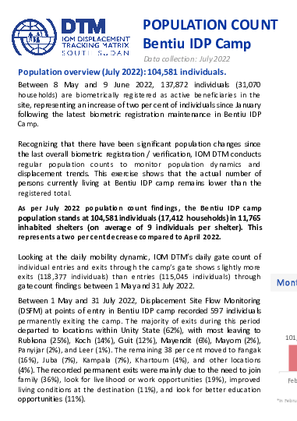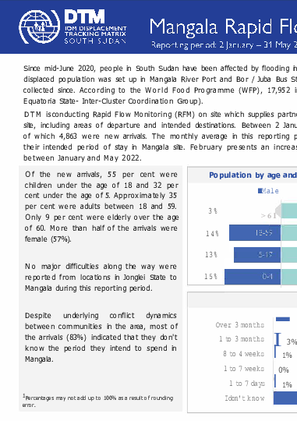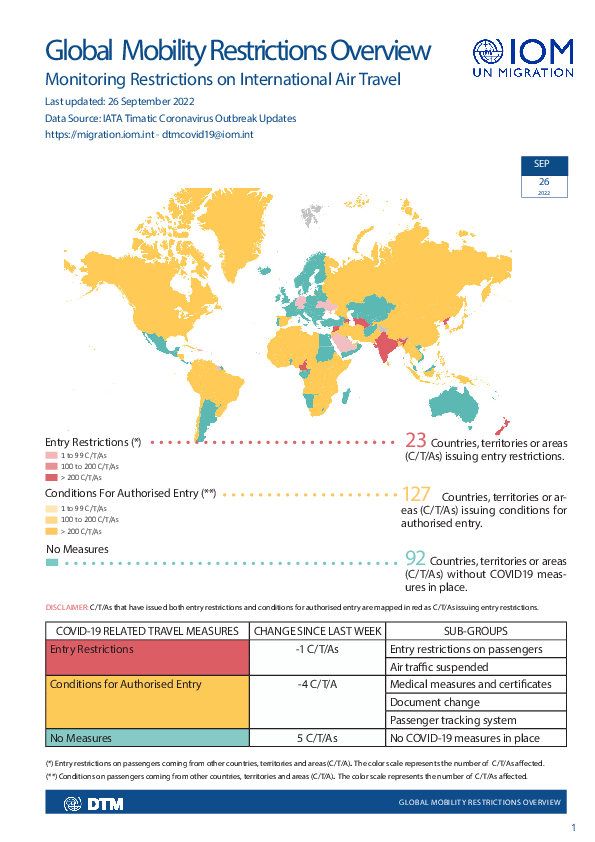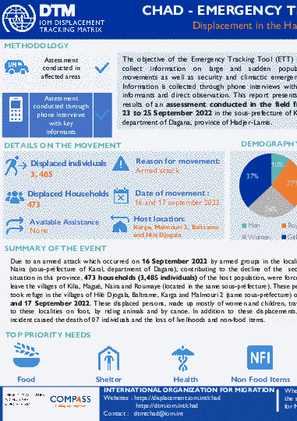-
Countries
-
Data and Analysis
-
Special Focus
-
Crisis Responses

Contact
DTM South Sudan, SouthSudanDTM@iom.int
Language
English
Location
South Sudan
Period Covered
Sep 01 2022
Sep 30 2022
Activity
- Registration
- Biometric Registration
Northern parts of Abyei Administrative Area (AAA) experienced rounds of localized conflict between February and March 2022. This led to displacement of people mostly from Amiet area leading to formation of Bokchop IDP site to accommodate internally displaced people (IDP) who were in search of safety within the neighbourhood of Abyei Town.
The International Organization for Migration’s Displacement Tracking Matrix (IOM DTM) in South Sudan maintains biometric registration database of IDPs in displacement sites. DTM carried out its first registration at Bokchop IDP site in September 2022. During the registration a total of 787 individuals belonging to 318 households where registered.
Forty-two per cent of the registered population were between 18 and 59 years of age, among which 28 per cent were female. The general overview of the registration shows that 52 per cent of the total population were females while 48 per cent were male. Among the recorded household sizes, individuals with household size one were most dominant (46%), followed by household size 2 (14%) and size 3 (14%). In the category of vulnerabilities, breastfeeding mothers were the most recorded individuals (4%).

Contact
DTM South Sudan, SouthSudanDTM@iom.int
Language
English
Location
South Sudan
Period Covered
Jul 20 2022
Jul 22 2022
Activity
- Registration
- Mobility Tracking
- Site Assessment
Rotriak is a location in Budang payam of Rubkona county and was initially a checkpoint for cargo heading to and from Sudan before the 2013 crisis. With the current flood displacement in Unity state, the affected population moved northward and settled in the dry areas at oil fields in Unity state. The area was then officially allocated by local authorities to the affected population as well as individuals who wish to relocate and settle in Rotriak. The demarcated area allocated for the displaced persons is 15 sqaure kilometers. The area is divided into 12 blocks and each block accommodates 280 – 299 plots of land.
On 24th May 2022, IOM’s Displacement Tracking Matrix conducted a rapid assessment to determine the magnitude of the humanitarian situation and estimate the population of Rotriak site. information was collected through Focus Group Discussions, key informant interviews and direct information.
Between 20 and 22 July 2022, IOM conducted population count at Rotriak Site. Blocks (1,2,3,4,5,6,7,8,9,11,12, and 14) are occupied and the total population of the site stands at 27,795 individuals. The population count findings at the eleven blocks show 53 per cent of the population are male, compared to 47 per cent female. Sixty per cent of the IDPs are between 0 – 18 years. Block 4 accommodates the highest number of IDPs (17%), followed by Block 3 (16%), Block 6 (12%), and Block 1 (11%). Almost all (97%) displaced persons cited that they intend to stay at the site.

Contact
DTM South Sudan, SouthSudanDTM@iom.int
Language
English
Location
South Sudan
Period Covered
Jul 01 2022
Jul 31 2022
Activity
- Registration
- Flow Monitoring
- Mobility Tracking
- Site Assessment
As per July 2022 population count findings, the Bentiu IDP camp population stands at 104,581 individuals (17,412 households) in 11,765 inhabited shelters (on average of 9 individuals per shelter). This represents a two per cent decrease compared to April 2022.

Contact
DTM South Sudan, SouthSudanDTM@iom.int
Language
English
Location
South Sudan
Period Covered
Jul 01 2022
Jul 31 2022
Activity
- Registration
- Flow Monitoring
- Mobility Tracking
- Site Assessment
Unity State has been experiencing flooding since 2019 in the counties of Mayendit, Leer, Panyijiar, and Koch. As a result of the flooding in Guit and Rubkona in 2021, Bentiu Town Sites (A, B, C, D, and E) were formed in August 2021. In order to provide accurate information on the Internally Displaced Persons (IDPs), the International Organization for Migration’s Displacement Tracking Matrix (IOM DTM) began conducting monthly population counts in November 2021, including questions on areas of habitual residence, areas of displacement, intentions to return or relocate and demographic information to inform partners.
As per July 2022 population count findings, the Bentiu Town Sites (A, B, C, D, and E) population stands at 57,924 individuals (on average 6 individuals per shelter). This shows a decrease of 194 individuals recorded during this period compared to April 2022.
Between 1 - 31 July 2022, Rapid Flow Monitoring (RFM) at points of entry in Bentiu Town Sites (A, B, C, D, and E) indicates an increase in new arrivals (72%). Twenty-eight per cent are found leaving the sites. Most of the increased new arrivals during this period were recorded in Site E (40%), Site D (18%), and Site C (9%), most of whom came from locations within Unity State (99%), with Guit County (35%), Leer (29%), Rubkona (17%), and Koch (10%), and others (9%). IDPs arriving at the sites travelled using boats (48%) or came by foot (41%).

Contact
DTM South Sudan, SouthSudanDTM@iom.int
Language
English
Location
South Sudan
Period Covered
Jan 01 2022
May 31 2022
Activity
- Other
- Flow Monitoring
Since mid-June 2020, people in South Sudan have been affected by flooding in areas along the White Nile. As numbers increased, a temporary site for the flood-displaced population was set up in Mangala River Port and Bor / Juba Bus Station, where the first group of IDPs arrived on 3 August 2020, and data has been collected since. According to the World Food Programme (WFP), 17,952 individuals/4,911 households are registered in Mangala as of 31 May 2021 (Central Equatoria State- Inter-Cluster Coordination Group).
D T M is conducting Rapid Flow Monitoring (RFM) on site which supplies partners with the number of new arrivals and a basic profile of populations arriving at the site, including areas of departure and intended destinations. Between 2 January and 31 May 2022, D T M surveyed 968 groups representing 5,453 individuals, of which 4,863 were new arrivals. The monthly average in this reporting period of new arrivals is 973 individuals, and most arrivals (83%) are not sure of their intended period of stay in Mangala site. February presents an increase in arrivals (1,640) at the port and bus station compared to other months between January and May 2022.

Contact
DTM Haiti, dtmhaiti@iom.int
Language
English
Location
Haiti
Period Covered
Jun 01 2022
Aug 31 2022
Activity
- Mobility Tracking
- Baseline Assessment
Since June 2021, an upsurge in violent confrontations between gangs has generated a situation of
generalized insecurity in several communes of the Metropolitan Area of Port-au-Prince (ZMPP)
and displaced tens of thousands of people. Insecurity in the capital, which accelerated following the
assassination of President Jovenel Moïse in July 2021, has aggravated the already dire economic and
political conditions confronting Haiti. The Haitian Directorate-General for Civil Protection (Direction
Générale de la Protection Civile, DGPC) and IOM’s Displacement Monitoring Matrix (DTM) recorded
47,129 new displacement movements in the ZMPP between 23 April and 23 August 2022. As of 1
September 2022, 21,684 individuals remain displaced in 36 spontaneous sites.
On 14 August 2021 an earthquake with an epicenter approximately 13 km southeast of Petit-Troude-
Nippes struck the departments of Nippes, South and Grand’Anse. This earthquake caused the death
of 2,246 people, as well as significant damage and destruction to more than 115,000 homes, and
affected over 800,000 people. IOM’s DTM and the DGPC estimate that at least 38,777 people were
forced to seek shelter in displacement sites following the earthquake, of which 2,528 remain displaced
in 35 sites.
Le rapport d’outil de veille sur la situation dans les quatre pays côtiers du golfe de Guinée (Ghana, Bénin, Togo et Côte d’Ivoire) à la date du 31 Juillet 2022, élaboré par le Groupe régional d’analyse intersectorielle (GRANIT) sous la direction et l’impulsion d’OCHA, de l’OIM et de REACH, fait le suivi, sur la base des données et analyses de partenaires humanitaires et de développement, des tendances relatives à des indicateurs clés reflétant la situation dans les quatre pays côtiers limitrophes du Burkina Faso, au 31 Juillet 2022.
Ainsi, le rapport examine l’évolution, pendant les cinq premiers mois de l’année 2022, au Ghana, Togo, Bénon et Côte d’Ivoire :
- des incidents sécuritaires
- des types et fréquences de violences
- des déplacements forcés de PDI et réfugiés
- de l’ouverture des frontières internationales
- de la sécurité alimentaire
- des dynamiques communautaires
- de la situation des droits de l’Homme.
Contact
DTM Burundi, DTMBurundi@iom.int
Location
Burundi
Activity
- Mobility Tracking
- Baseline Assessment
Period Covered
Jul 04 2022 -Jul 24 2022
A baseline assessment is a sub-component of mobility tracking. It aims to collect data on IDP, migrant or returnee population presence in a defined administrative area of the country.
Population Groups
Survey Methodology
Unit of Analysis Or Observation
Type of Survey or Assessment
Keywords
Geographical Scope
Administrative boundaries with available data
The current dataset covers the following administrative boundaries

Contact
DTMcovid19@iom.int
Language
English
Location
Global
Period Covered
Sep 19 2022
Sep 26 2022
Activity
- Other
The DTM Global Mobility Restrictions Overview provides updates on international air travel restrictions and conditions for authorized entry. This overview aims to understand how COVID-19 has impacted human mobility, detailing how global and regional trends in air travel measures have evolved since COVID-19 was declared a global pandemic in March 2020. The data presented focuses on the changes in public health-related immigration and border management measures. It provides information intended to support IOM missions and partners in targeted response planning and advocacy for vulnerable populations who may be affected by changes in global mobility.

Contact
DTM Chad, dtmtchad@iom.int
Language
English
Location
Chad
Period Covered
Sep 23 2022
Sep 25 2022
Activity
- Mobility Tracking
- Event Tracking
Due to an armed attack which occurred on 16 September 2022 by armed groups in the locality of Naira (sous-préfecture of Karal, department of Dagana), contributing to the decline of the security situation in this province, 473 households (3,485 individuals) of the host population, were forced to leave the villages of Kilia, Magué, Naira and Roumaye (located in the same sous-préfecture). These people took refuge in the villages of Hilé Djogala, Baltrame, Karga and Malmouri 2 (same sous-préfecture) on 16 and 17 September 2022

